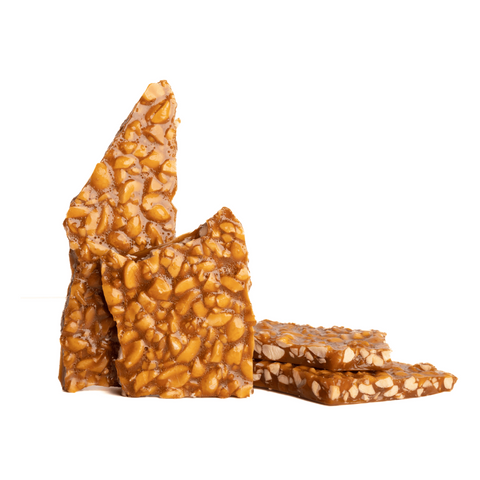What is Brittle, Bark, Buttercrunch, Bars, etc
What's the difference between brittle, bark, bars, and buttercrunch candy? Let's break it down the best way we can:
Brittle:
- Thin, flat candy made by cooking sugar or syrup until hard and brittle, stirring in nuts and sometimes other additions like seeds or dried fruit.
- Known for its irregular, shattered texture and tendency to break into small pieces.
- Examples: Peanut brittle, pecan brittle, sesame brittle.
Bark:
- Primarily a chocolate base and sometimes thicker than brittle and often poured onto a baking sheet to create a bark-like appearance.
- Can be made with various ingredients like different chocolate types, white chocolate, nuts, dried fruit, pretzels, candy canes and more.
- Offers a variety of textures depending on the ingredients used, from smooth and creamy to crunchy.
- Examples: Chocolate bark, yogurt bark, trail mix bark.
Shards:
- A general term for small, thin pieces of candy that can be made from various methods, including breaking up brittle, bark, or chocolate bars.
- Often used as a decorative element or topping for desserts.
- Texture can vary depending on the source material, but usually thin and crispy.
- Examples: Chocolate shards, peanut butter shards, toffee shards.
Bars:
- A broad category encompassing many different types of candy formed into a bar shape.
- Can be made with various ingredients and processes, including molding, enrobing, layering, and pressing.
- Texture can vary greatly depending on the ingredients and method used, from soft and chewy to hard and crunchy.
- Examples: Chocolate bars, granola bars, nougat bars, fudge bars.
Buttercrunch:
- A type of brittle made with butter, sugar, and nuts.
- Known for its buttery flavor and toffee-like texture, which is harder and chewier than regular brittle.
- Often has a distinctive honeycomb-like appearance due to the addition of baking soda.
- Examples: Peanut buttercrunch, cashew buttercrunch, almond buttercrunch.
Other cool candy facts:
Candy can be traced back as far as 2000BC to ancient Egypt where candy was used in ceremonies for worshiping their gods and goddesses. The Egyptians used honey to make candy by adding figs, nuts, dates and spices.
The history of sweet treats stretches back thousands of years, with different cultures developing their own versions using readily available ingredients. Here's a timeline highlighting some key points:
Ancient Times:
- Pre-Sugar Era: Early humans likely combined honey with nuts and fruit for a sweet treat. Evidence of honey-based candies exists in ancient Egypt (1500 BC) and China (3000 BC).
- Sugarcane & Chocolate: The Persians and Greeks discovered sugarcane around the 6th-4th centuries BC, leading to the production of sugar. Meanwhile, Mesoamericans were fermenting chocolate into beverages as early as 350 BC.
Medieval Era:
- Spiced Candies: Sugar became more available, but still expensive. Candies were mainly enjoyed by the wealthy and used as digestive aids, combining sugar with spices like ginger and cloves.
Modern Era:
- Industrialization: Sugar production boomed in the 18th and 19th centuries, making candy more accessible. New processes led to innovative candy forms like lozenges, caramels, and chocolate bars.
While we can't credit one individual with inventing candy, we can appreciate the long history and cultural diversity that led to the current day treats which make our life that much sweeter.

